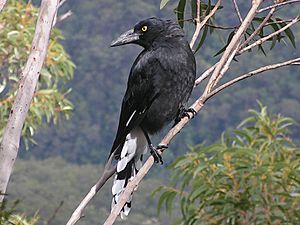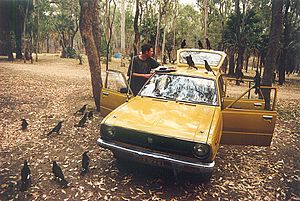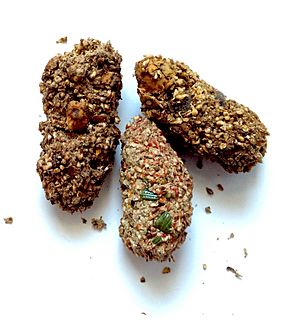Pied currawong facts for kids
Quick facts for kids Pied currawong |
|
|---|---|
 |
|
| Subspecies graculina, Blue Mountains | |
| Conservation status | |
| Scientific classification | |
| Genus: |
Strepera
|
| Species: |
graculina
|
 |
|
| Pied currawong range | |
The pied currawong (Strepera graculina) is a medium-sized black bird found in eastern Australia and Lord Howe Island. It's one of three currawong species and is related to butcherbirds and the Australian magpie.
This bird is about 48 cm long. It has black or dark grey feathers with white patches under its tail and on its wings. Its eyes are yellow, and it has a strong bill. Males and females look similar. The name currawong comes from Indigenous words that sound like the bird's calls.
Pied currawongs usually stay in one area, but those living in high places move to lower areas in winter. They eat many different things, like berries, seeds, insects, bird eggs, young birds, and even small marsupials. They are predators that have learned to live well in cities, so you can find them in parks and gardens, as well as in forests. They prefer mature forests for breeding. Unlike the Australian magpie, which hunts on the ground, currawongs mostly find food and nest in trees.
Contents
What is a Pied Currawong?
The pied currawong was first described in 1790 by an English scientist named George Shaw. Its scientific name, Strepera graculina, comes from Latin words. Strepera means "noisy," and graculina means "like a jackdaw" (another type of bird).
People used to call it the "pied crow-shrike." The word "pied" means it has two or more colors in patches. Other old names include "pied chillawong" and "mutton-bird." The name currawong sounds like the bird's call. It likely comes from Indigenous languages, such as garrawaŋ from the Jagera language or gurawaruŋ from the Darug language.
The pied currawong is closely related to the black currawong and the grey currawong. Even though they look a bit like crows, currawongs are not true crows. They belong to a family called Artamidae, which also includes the Australian magpie and butcherbirds.
Different Types of Pied Currawongs
There are six recognized types, or subspecies, of the pied currawong. They mostly differ in size and how dark their feathers are. Birds found further south tend to be lighter grey, larger, and have shorter bills. They also have more white on their tails and less white on their wings.
- S. g. graculina is the most common type. It lives from Sydney north to Queensland.
- S. g. ashbyi is a type from western Victoria. It is considered critically endangered.
- S. g. crissalis is the Lord Howe currawong. It lives on Lord Howe Island and is vulnerable. There are only about 70-80 of these birds.
- S. g. magnirostris lives in northern Queensland and has a longer, heavier bill.
- S. g. robinsoni is found in northeastern Queensland and is smaller than other types.
- S. g. nebulosa lives in southeastern New South Wales, the Australian Capital Territory, and central Victoria. It is similar to the main type but has a shorter bill and longer tail.
What Does a Pied Currawong Look Like?
The pied currawong is mostly black with white patches on its wings, under its tail, and on the tip of its tail. It has bright yellow eyes. Adult birds are usually between 44 and 50 cm long, with an average length of about 48 cm. Their wingspan can be from 56 to 77 cm. Adult males weigh around 320 grams, and females weigh about 280 grams.
Their bill is long, heavy, and hooked at the end. Young birds look similar to adults but have softer, brownish feathers. Their white tail band is also narrower. Young birds have dark brown eyes and a dark bill with a yellow tip. As they get older, their feathers become darker until they look like adults. These birds can live for more than 20 years in the wild.
What Sounds Do They Make?
Pied currawongs are very noisy birds. They call while flying and throughout the day. They are loudest in the early morning, in the evening before they go to sleep, and before it rains. Their loud, special call sounds like Kadow-Kadang or Curra-wong. They also make a loud, high-pitched whistle that sounds like Wheeo. The currawongs on Lord Howe Island have a unique, more musical call.
Birds That Look Similar
It's easy to confuse pied currawongs with other birds. The smaller white-winged chough looks similar but has red eyes and mostly stays on the ground. Australian crows and ravens have white eyes and no white patch on their rump. The Australian magpie, which is about the same size, has red eyes and clear black and white feathers. The larger grey currawong is lighter grey and doesn't have white feathers at the base of its tail.
Where Do Pied Currawongs Live?
Pied currawongs are common in many types of forests and in towns across eastern Australia. They live from the Cape York Peninsula down to western Victoria and on Lord Howe Island. They have adapted well to living near people and have become more common in many areas, especially in Sydney and Canberra since the 1940s and 1960s. They used to only visit these cities in winter but now live and breed there all year.
These birds usually stay in one place. However, some populations that live in high mountains move to lower areas during winter. Pied currawongs can fly across water. They have been seen on islands off the coast of Victoria and Queensland. The currawongs on Lord Howe Island probably arrived there by chance.
Pied currawongs can affect smaller birds. Some studies suggest they can be a problem because they eat eggs and young birds from nests. For example, they have caused problems for Gould's petrels on Cabbage Tree Island by eating adult seabirds. When the currawongs were removed from these islands, the petrel population stopped declining. A study in 2006 found that protecting nests from currawongs helped eastern yellow robins and scarlet robins breed more successfully.
These birds also help spread weeds by eating fruits and then dropping the seeds in new places. In the past, people shot currawongs because they ate corn and strawberries. They were also shot on Lord Howe Island for attacking chickens. However, they are helpful in forests because they eat phasmids (large insects) and help farmers by eating cocoons of the codling moth.
How Do Pied Currawongs Behave?
Pied currawongs usually live in trees. They hunt and find food several meters above the ground. This allows them to share areas with Australian magpies, which mostly hunt on the ground. At night, currawongs sleep in forests or large trees. In the morning, they spread out to find food and return in the late afternoon.
While they are often alone or in small groups, they can form larger flocks of 50 or more birds in autumn and winter. When on the ground, a pied currawong moves by hopping or strutting.
During breeding season, pied currawongs form pairs and protect their nesting and feeding areas. They will chase away threats like ravens. They make snapping sounds with their bills, dive at intruders, and chase them in the air. Males are usually the ones defending their territory and guarding the female while she builds the nest.
Sometimes, flocks of currawongs seem to play. One bird might sit on top of a tall tree or pole, and others will swoop, tumble, or dive to try and knock it off. If a bird succeeds, it then becomes the target for others.
Pied currawongs bathe by walking into water about 15 cm deep. They squat down, put their head under the water, and shake their wings. Afterward, they clean their feathers. They have also been seen anting, which means rubbing ants on their feathers.
Life Cycle and Reproduction
Pied currawongs prefer to breed in mature forests. In spring, they build a nest of thin sticks lined with grass and bark high up in trees, usually eucalypts. They lay about three eggs. The eggs are light pinkish-brown with darker spots. They are oval-shaped and about 30 x 42 mm.
Only the female sits on the eggs. It's hard to watch their nests, but it seems the eggs hatch after about 30 days. Like all songbirds, the chicks are born naked and blind. They stay in the nest for a long time. They quickly grow a layer of grey downy feathers. Both parents feed the young birds, but the male only starts feeding them directly a few days after they hatch.
Sometimes, the channel-billed cuckoo lays its eggs in pied currawong nests. The currawongs then raise the cuckoo chicks, thinking they are their own. The cuckoo eggs look very similar to currawong eggs. Pied currawongs have been known to leave their nests if cuckoos visit, abandoning their own young, which then die. A channel-billed cuckoo was even seen cutting off the head of a currawong chick. Other animals like the brown goshawk and lace monitor also eat young currawongs from nests.
What Do Pied Currawongs Eat?
The pied currawong eats many different things. It eats fruits and berries, and it also hunts insects and smaller animals. It mostly preys on young birds and bird eggs, but sometimes it can catch healthy adult birds, even as big as a Crested pigeon.
Currawongs hunt in trees, taking birds and eggs from nests, as well as insects and berries from branches. They also hunt in the air and on the ground. In summer, they eat mostly insects, and in winter, they eat more fruit. They often scavenge for food, eating scraps and rubbish. They can be quite bold when looking for food from people, hanging around picnic areas and bird feeders. Beetles and ants are the most common insects they eat. Pied currawongs have also been seen taking mice, and even chickens and turkeys from farms.
They eat many types of fruit, including different kinds of figs, lillypillies, white cedar, plum pine, and geebungs. They also raid orchards, eating apples, pears, strawberries, grapes, and corn. Pied currawongs have helped spread invasive plants like Asparagus aethiopicus, privet species, and firethorn.
In summer, birds hunt alone or in pairs. In autumn and winter, they often form larger flocks and are more likely to be found near people and in cities. They sometimes hunt with Australian magpies or common starlings. They have also been seen with grey currawongs and satin bowerbirds. Pied currawongs have been known to steal food from other birds like the Australian hobby and sulphur-crested cockatoo. They also bother each other. A study in 2007 found that white-browed scrubwren chicks became silent when they heard the sound of a pied currawong walking through leaves.
Images for kids
See also
 In Spanish: Verdugo pío para niños
In Spanish: Verdugo pío para niños








